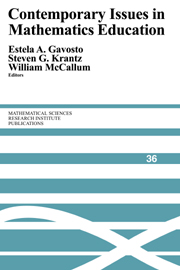Book contents
Is the Mathematics We Do the Mathematics We Teach?
Published online by Cambridge University Press: 27 June 2025
Summary
In a recent article [7], William Thurston called attention to the sad state of the mathematics classroom:
We go through the motions of saying for the record what the students “ought” to learn while students grapple with the more fundamental issues of learning our language and guessing at our mental models. Books compensate by giving samples of how to solve every type of homework problem. Professors compensate by giving homework and tests that are much easier than the material “covered” in the course, and then grading the homework and tests on a scale that requires little understanding. We assume the problem is with students rather than communication: that the students either don't have what it takes, or else just don't care. Outsiders are amazed at this phenomenon, but within the mathematical community, we dismiss it with shrugs.
This brings up the question: Does what is taught in the typical mathematics course even qualify as mathematics?
In another article in the same issue of the Bulletin [4], Saunders Mac Lane offered:
intuition - trial - error - speculation - conjecture – proof
as a sequence for understanding of mathematics. In contrast, the sequence in place in most modern mathematics courses is:
lecture - memorization - test.
Most working mathematicians agree with MacLane's description, thus leaving the inescapable conclusion that the mathematics we do is not the same as what is commonly offered in the classroom. The questions for the next century are:
• Can the mathematics we offer in the classroom be more like the mathematics we do?
• Can we ignite students’ mathematical interest?
• What role can computers play in dealing with these questions?
Information
- Type
- Chapter
- Information
- Contemporary Issues in Mathematics Education , pp. 67 - 74Publisher: Cambridge University PressPrint publication year: 1999
